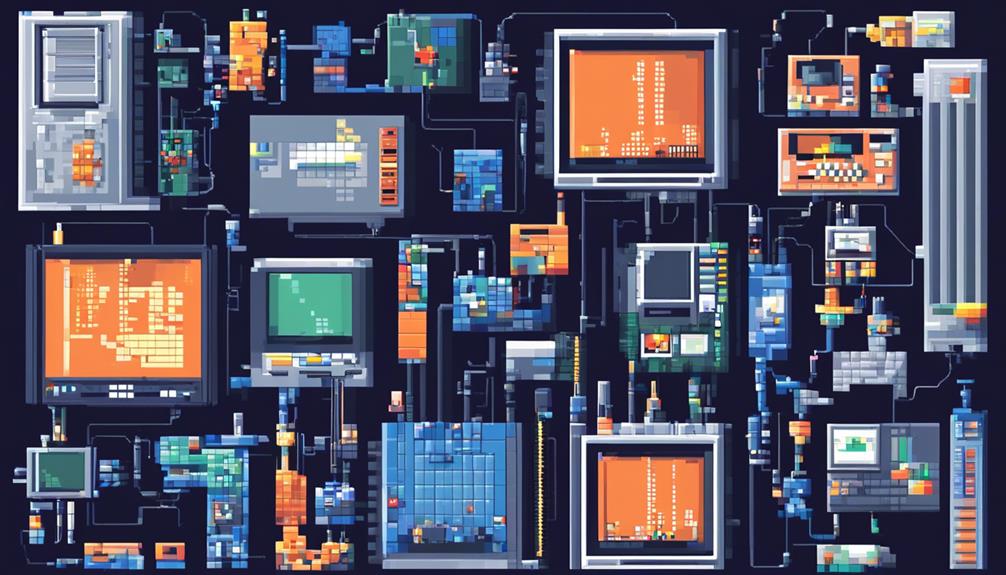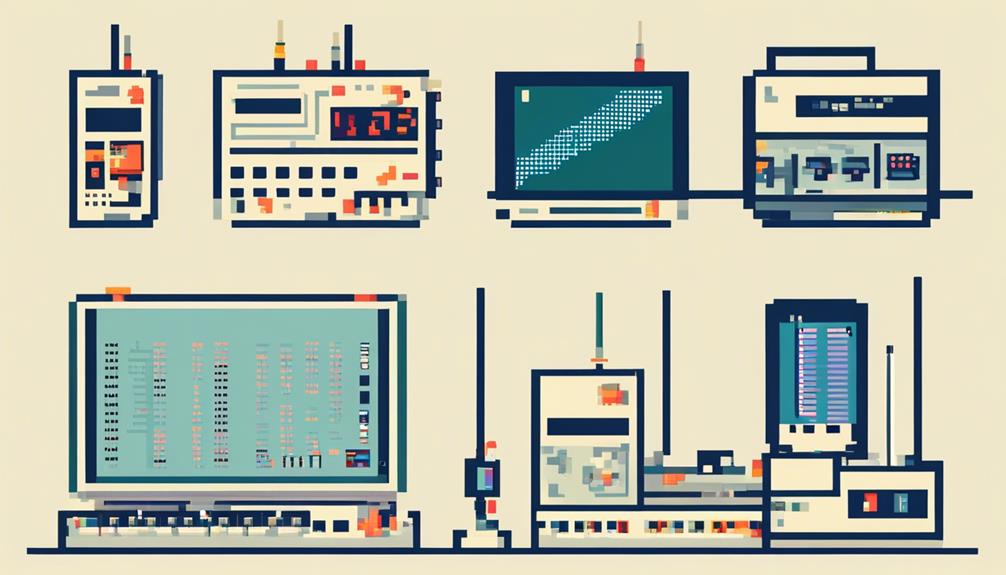The world of telecommunication hardware has journeyed through a remarkable evolution, witnessing significant advancements and transforming the way we connect and communicate.
From ancient communication systems like smoke signals and drums to the groundbreaking inventions of the telegraph and telephone, the course of history has been shaped by these technological marvels.
The advent of radio and television revolutionized long-distance communication, while the introduction of the internet and digital communication transformed the way we share information.
However, the evolution did not stop there. With the emergence of satellite and wireless technology, the reach of communication expanded further, promising faster and more reliable connections.
As we stand on the brink of the rollout of 5G networks, the future of telecommunications holds vast potential for connectivity, efficiency, and innovation.
Let us delve into this fascinating journey of innovation and discover how telecommunication hardware has been instrumental in shaping our interconnected world.
Key Takeaways
- Signal fires, drum messages, smoke signals, and smoke signals in ancient China were early forms of communication systems used by different cultures.
- The invention of the telegraph and Morse Code revolutionized long-distance communication, introducing the concept of electrical signals.
- The electric telephone, mobile technology, and the rise of the Internet led to advancements in telecommunication systems, enabling wireless communication and the use of VoIP technology.
- Advancements in radio technology and the development of television transformed mass communication, playing a vital role in modern society.
Ancient Communication Systems

Ancient communication systems encompassed a diverse array of methods, including signal fires, smoke signals, drum messages, and various signaling techniques unique to different regions and cultures. These early forms of communication were the foundation for the evolution of telecommunication hardware. In ancient times, people relied on these methods to transmit messages over long distances.
Signal fires were one of the most common means of long-distance communication. By lighting fires on hilltops or other elevated locations, people could send signals to nearby communities. The smoke produced by these fires could convey important information such as danger, victory, or the arrival of travelers.
Drum messages were another effective method of communication. In Africa, for example, talking drums were used to transmit complex messages. Skilled drummers could produce a wide range of sounds and rhythms, allowing them to convey specific meanings. This form of communication was particularly useful in areas with dense forests or rugged terrain where other methods were impractical.
Different regions and cultures developed their own unique signaling techniques. In North America, Native American tribes used smoke signals to communicate across vast distances. Similarly, ancient China utilized a sophisticated system of smoke signals to transmit military messages.
These ancient communication systems laid the foundation for the evolution of telecommunication networks. From the acoustic telephone developed by Robert Hooke in 1672 to the optical telegraph system by the Chappe brothers in 1790, early telecommunication devices were influenced by these ancient methods. The invention of the electrical telegraph and the subsequent laying of the transatlantic telegraph cable revolutionized long-distance communication in the 19th century.
Telegraph and Morse Code
The advancement of telecommunication hardware from ancient communication systems led to the development of the telegraph and Morse Code, revolutionizing long-distance communication through the transmission of electrical signals. Invented by Samuel Morse, the telegraph became a groundbreaking invention in the field of telecommunication. It allowed messages to be sent quickly and efficiently over vast distances, overcoming the limitations of previous communication methods.
Morse Code, also developed by Samuel Morse, was the coding system used with the telegraph. It consisted of a series of dots and dashes that represented letters, numbers, and other characters. This simple yet effective coding system enabled coded communication to be transmitted over the telegraph, making it an essential tool for long-distance communication.
The telegraph and Morse Code played a crucial role in the evolution of telecommunication technology. Their invention marked a significant milestone in the field, as they introduced the concept of electrical signals being used to transmit messages across long distances. This breakthrough paved the way for future developments in telecommunication and laid the foundation for the technological advancements that we enjoy today.
To provide a visual representation of the Morse Code system, the following table displays the coding for each letter of the alphabet and the numbers:
| Letter | Morse Code |
|---|---|
| A | .- |
| B | -… |
| C | -.-. |
| D | -.. |
| E | . |
This table continues to list the remaining letters and numbers, showcasing the intricate coding system that Morse Code utilized. Through the telegraph and Morse Code, communication underwent a significant transformation, enabling messages to be transmitted across vast distances at unprecedented speeds. This technological evolution paved the way for the telecommunication systems we rely on today.
Telephone Revolution

The telephone revolutionized communication with the invention of the electric telephone in the 1870s, marking a significant advancement in telecommunication technology. Alexander Graham Bell, who held the master patent for the electric telephone, played a pivotal role in this revolution. This invention allowed for the transmission of voice signals over long distances, replacing the need for written communication through telegraph wires and Morse code.
Over the years, the telephone has evolved from its initial form to become an integral part of our daily lives. The advent of mobile technology has brought about a new era in telecommunications, enabling people to communicate wirelessly while on the move. With the rise of the Internet, the telephone has further evolved to include voice-over-Internet-Protocol (VoIP) technology, allowing for digital voice communication over the Internet.
Telecommunications networks have also undergone a significant transformation. From the early days of telephony, which relied on analog signals transmitted through copper wires, we now have highly advanced digital networks. Fiber-optic cables have replaced traditional copper wires, enabling faster and more reliable transmission of voice and data signals. Additionally, satellite technology has been instrumental in intercontinental long-distance telephony, further expanding the reach of telecommunications networks.
The telephone revolution has brought about a fundamental shift in how we communicate with one another. It has connected people across vast distances, allowing for instant voice communication. As technology continues to advance, we can expect further enhancements and innovations in telecommunication hardware, ensuring that our communication networks are more efficient, reliable, and accessible to all.
Radio and Television Broadcasting
Radio and television broadcasting have played a pivotal role in the evolution of telecommunication hardware.
The early advancements in radio technology, pioneered by Guglielmo Marconi, enabled wireless long-distance communication and paved the way for the rise of broadcasting.
Simultaneously, the contributions of Jagadish Chandra Bose, Kenjiro Takayanagi, and John Logie Baird led to the development of television, revolutionizing mass communication and entertainment.
These advancements in broadcasting have significantly shaped the landscape of telecommunication hardware and continue to play a vital role in modern society.
Early Radio Technology
Early in the 20th century, the invention of wireless telegraphy by Guglielmo Marconi revolutionized long-distance communication by eliminating the need for physical wires. This groundbreaking invention paved the way for the evolution of early radio technology, which played a significant role in the development of telecommunication hardware.
Here are three key aspects of early radio technology:
- Radio Broadcasting: The invention of wireless telegraphy led to the popularization of radio broadcasting in the early 20th century. This allowed for the transmission of audio signals over long distances, enabling the mass dissemination of news, entertainment, and cultural programs.
- Mobile Telephony: The concept of mobile communications was born with the invention of radio technology. By transmitting electrical signals wirelessly, individuals were able to communicate with one another without being physically connected to a telephone line.
- The Impact of Digital Technology: Early radio technology laid the foundation for the advancement of digital telecommunication. The introduction of the Public Switched Telephone Network (PSTN) and the integration of digital technology revolutionized the way in which telecommunication systems operated, leading to increased efficiency and improved connectivity.
Rise of Television
The emergence of television broadcasting revolutionized the telecommunication industry, offering a new medium for the transmission of audiovisual content.
In the early 20th century, telephony and telegraph were already enabling people to connect across long distances using electrical signals. However, television took this to a whole new level by allowing not only voice but also visual communication.
With the development of telecommunication hardware, such as cathode-ray tubes, mechanical television systems were able to transmit moving images. Pioneers like John Logie Baird paved the way for the rise of television, introducing color television and improving picture quality.
This new medium brought entertainment, news, and educational content into people's homes, and it continues to evolve and thrive in the digital age. Television broadcasting has become an integral part of our lives, connecting people and transmitting audiovisual content across the globe.
Broadcasting Advancements
Advancements in broadcasting technology have revolutionized the way audiovisual content is transmitted and received, shaping the telecommunication industry. These advancements have brought about significant changes in the field of broadcasting, allowing for the seamless transmission of information over vast distances.
Here are three key advancements that have played a crucial role in this evolution:
- Radio: The invention of radio by Guglielmo Marconi paved the way for wireless communication. It allowed for the transmission of audio signals without the need for physical wires, enabling people to access news, music, and entertainment from anywhere in the world.
- Television: The development of television technology, pioneered by individuals like Jagadish Chandra Bose and Kenjiro Takayanagi, revolutionized the way visual content is broadcasted. Mechanical television, demonstrated by John Logie Baird, evolved into color television, thanks to cathode-ray tubes.
- Digital Broadcasting: With the advent of digital technology, broadcasting has become more efficient and versatile. Digital signals allow for better picture and sound quality, as well as the transmission of additional data. This has opened up possibilities for interactive television, video-on-demand services, and streaming platforms over the internet.
These advancements in broadcasting have transformed the way we consume audiovisual content, making it more accessible, immersive, and diverse.
Semiconductor Innovations
Semiconductor innovations have revolutionized the field of telecommunication hardware, paving the way for significant advancements in chip technology. These breakthroughs have resulted in the development of smaller, more powerful, and energy-efficient electronic components.
By harnessing the potential of semiconductor materials, such as silicon, telecommunication devices have become faster, more efficient, and capable of handling complex tasks.
The continuous progress in semiconductor advancements has played a pivotal role in the evolution and enhancement of telecommunication hardware.
Chip Advancements
Chip advancements have revolutionized the field of telecommunication hardware, paving the way for unprecedented levels of miniaturization, performance, and efficiency. These advancements have played a significant role in the evolution of telecom devices, offering faster speeds and improved functionality.
Here are three ways chip advancements have transformed telecommunication hardware:
- Miniaturization: Chip innovations have allowed for the creation of smaller and more compact devices, such as mobile phones. This has made communication more convenient and portable than ever before.
- Enhanced Performance: The integration of advanced semiconductor materials and manufacturing processes has resulted in improved data processing capabilities. This enables telecommunication devices to handle complex tasks efficiently and effectively.
- Cost Reduction: Chip advancements have led to reduced costs in telecommunication hardware production. This has made communication devices more accessible to a wider range of people, promoting connectivity and bridging the digital divide.
The late 20th century brought about a new era in telecommunication hardware, and chip advancements continue to drive innovation in the field, shaping the future of communication technology.
Semiconductor Breakthroughs
The breakthroughs in semiconductor technology have revolutionized the field of telecommunication hardware, enabling the creation of smaller, faster, and more efficient electronic devices. Innovations in semiconductor technology have led to the development of integrated circuits, which have played a crucial role in the miniaturization of telecommunication equipment and the enhancement of their performance. The use of semiconductor materials like silicon and gallium arsenide has significantly improved the efficiency and reliability of telecommunication devices. These advancements have also facilitated the development of high-speed and high-frequency components, which are essential for modern telecommunication systems. Moreover, the utilization of semiconductor materials has enabled the creation of advanced signal processing and amplification technologies, further contributing to the evolution of telecommunication hardware.
| Semiconductor Breakthroughs | Telecommunication Hardware | Evolution |
|---|---|---|
| Miniaturization of telecommunication equipment | Increased efficiency and reliability | Advancements in signal processing and amplification |
| Development of integrated circuits | Enhanced performance | Creation of high-speed and high-frequency components |
| Utilization of semiconductor materials | Smaller, faster, and more efficient electronic devices | Innovation in telecommunication technology |
Videotelephony and Satellite Communication

Videotelephony and satellite communication have revolutionized global connectivity by enabling real-time transmission of video and audio over long distances. These technologies have significantly improved global connectivity and accessibility to communication services.
Here are three key aspects of videotelephony and satellite communication:
- Enhanced Communication:
Videotelephony allows individuals to communicate face-to-face, regardless of their physical location. This technology has opened up new possibilities for professional collaboration, remote healthcare services, and connecting with loved ones across the globe. By transmitting video and audio in real-time, videotelephony provides a sense of immediacy and personal connection that was previously limited to in-person interactions.
- Global Coverage:
Satellite communication utilizes satellites to relay signals, enabling communication in remote areas and facilitating intercontinental long-distance communication. This technology has bridged geographical barriers, allowing people in even the most isolated regions to connect with the rest of the world. It plays a crucial role in providing telecommunication services to underserved areas, supporting emergency response efforts, and facilitating international business operations.
- Future Possibilities:
Videotelephony and satellite communication are poised to play a significant role in the future of telecom and the Internet of Things (IoT). As the number of IoT devices continues to grow, these technologies will be essential for enabling seamless data transmission and communication between devices. Additionally, advancements in satellite technology hold promise for improving the speed, capacity, and efficiency of wireless communications, paving the way for even more innovative applications.
Computer Networks and the Internet
Computer networks and the internet have revolutionized the way people communicate and access information in the modern world. The evolution of telecommunication hardware, from the telegraph to the telephone to telephony, has led to a paradigm shift with the introduction of computer networks and the internet.
The development of computer networks has played a crucial role in the evolution of telecommunication hardware. In the 1960s, packet switching technology emerged, allowing data to be broken into smaller packets and transmitted over networks. This innovation paved the way for the creation of the internet.
The internet, which is a global network of interconnected computers, has transformed communication by enabling individuals to exchange information and ideas instantly. It has become an essential tool for businesses, governments, and individuals, facilitating communication, collaboration, and access to vast amounts of information. The internet has also facilitated the rise of social media platforms, changing the way people interact and share information.
Wireless networks have further expanded the reach and accessibility of the internet. With the advent of wireless communication technologies such as Wi-Fi and cellular networks, individuals can now connect to the internet from virtually anywhere, using laptops, smartphones, and other devices.
Switching systems have also evolved to support the demands of computer networks and the internet. From traditional circuit-switched systems to more efficient packet-switched systems, telecommunication hardware has adapted to accommodate the increasing volume of data transmitted over networks.
Wireless Technology Advancements

Wireless technology has experienced significant advancements in recent years, revolutionizing the way we connect and communicate in an increasingly interconnected world. These advancements have greatly improved the efficiency and reliability of telecommunication hardware, enabling seamless wireless connectivity across various devices and locations.
Here are three notable advancements in wireless technology:
- 5G Networks: The development of 5G networks has brought about a new era of wireless communication. With faster speeds, lower latency, and the ability to connect a greater number of devices simultaneously, 5G networks have transformed the way we experience wireless connectivity. This advancement has enabled faster downloads, smoother streaming, and enhanced browsing experiences.
- Satellite Communication: Satellite communication has played a crucial role in extending wireless connectivity to remote areas. It has allowed for transcontinental telephone calls, enabling people to communicate across vast distances. Furthermore, satellite communication has facilitated the spread of television networks across large countries, providing access to a wide range of content.
- Remote Healthcare Services: Wireless technology advancements have also revolutionized the field of healthcare. Through telephony and the use of Internet Protocol (IP), healthcare providers can now offer remote healthcare services. This includes remote patient monitoring, teleconsultations, and telemedicine. Wireless technology has made it possible for healthcare professionals to provide timely and efficient care to patients regardless of their location.
The rapid growth of wireless technology has not only improved our daily lives but also transformed industries such as customer service, where voice calls can now be made from any location. As wireless technology continues to advance, we can expect even greater innovation and connectivity in the future.
Frequently Asked Questions
How Has Telecommunications Evolved Over Time?
Telecommunications has evolved significantly over time, impacting modern society in numerous ways.
Advancements in telecommunication infrastructure have allowed for faster and more reliable communication, facilitating the rise of mobile devices and the internet revolution.
Telecommunication plays a crucial role in business communication, enabling global connectivity and changing the face of communication.
As technology continues to advance, the future of telecommunication holds even greater potential, with the potential for faster speeds, enhanced networks, and further integration with other technologies.
What Is a Telecommunication Hardware?
Telecommunication hardware refers to the devices and equipment used in transmitting data and facilitating communication over long distances. It plays a crucial role in global communication by enabling the transfer of information through various technologies, such as telegraphs, telephones, internet, and wireless communication.
Telecommunication hardware encompasses a wide range of devices, including telephones, routers, switches, and modems. These components have evolved over time, from early forms of communication to modern advancements like cellular towers, fiber-optic networks, and VoIP technology.
The future of telecommunication hardware lies in the expansion of 5G networks, integration with artificial intelligence, and sustainable practices.
Who Invented the First Telecommunication Device?
The first telecommunication device was invented by Samuel Morse. His invention, the telegraph, had its historical origins in the early communication devices of the 19th century. Morse's motivation was to create a system that could transmit messages over long distances at a faster pace than traditional means.
The telegraph had a profound impact on society, leading to a communication revolution and the establishment of early telecommunication networks. This marked the transition from telegraphy to telephone technology, with subsequent innovations shaping modern communication systems.
What Is the Technology Behind Telecommunication?
Telecommunication technology encompasses a wide range of technologies and systems that enable wireless communication, data transmission, and internet connectivity.
Key components of this technology include fiber optics for high-speed data transmission, satellite technology for long-distance communication, and Voice over IP (VoIP) for internet-based voice communication.
Mobile telephony plays a crucial role in providing telecommunication services through cellular networks.
Telecommunication protocols and network infrastructure enable the efficient transmission of data and communication across various devices and platforms.

